Topic: Variation Of Traits Due To Environmental Factors
Variation Of Traits Due To Environmental Factors
The activity of a single-celled organism is represented in the diagram below.
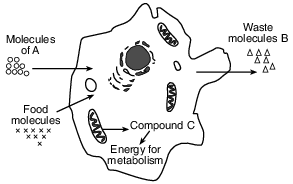
Which concept is best illustrated by this diagram?
(1) The life functions performed by single-celled organisms are different from the life functions performed by complex organisms.
(2) Single-celled organisms carry out life functions that are essential for survival.
(3) Since single-celled organisms lack organs, they can survive only in moist environments.
(4) Single-celled organisms contain one organelle that performs all the life functions.
The chart below shows a comparison of the blood sugar levels for two individuals who took part in a scientific study.
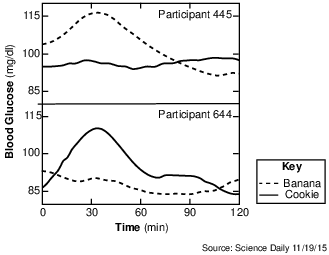
Scientists have observed that blood sugar levels rose by different amounts in the two individuals even though they were given identical portions of bananas and cookies. These results were obtained because
(1) glucose is too large a molecule to be absorbed into the blood, so the researchers were only measuring the amount of glucose already present
(2) participant 445 didn’t like bananas, and his body absorbed more of the food that he likes
(3) individuals have genetic differences that alter their responses to environmental factors
(4) two different foods were used; the scientists should have had only one experimental variable
Plants are green because they contain the protein chlorophyll. A bucket was left on the lawn for one week. When the bucket was removed, the grass under the bucket had turned from green to a yellowish white color. This change is due to the interaction between the grass and
(1) decomposer organisms in the soil, an abiotic factor
(2) the amount of sunlight, an abiotic factor
(3) increased moisture under the bucket, a biotic factor
(4) the metal composition of the bucket, a biotic factor
In the summer, the arctic fox appears brown because its cells produce a dark pigment. However, in the winter, the arctic fox appears white because the dark pigment is not produced. The color change is most likely due to the effect of
(1) different genes produced in the different seasons
(2) increased pollution on genetic mutations
(3) environmental conditions on gene expression
(4) poor nutrition on cell growth and development
Researchers recently discovered that when hammerhead sharks were moved to shallower water, resulting in exposure to increased light intensity, their backs turned a deep brownish black. Which statement best supports this observation?
(1) Genes are inherited, but their expression can be modified by interactions with the environment.
(2) The cells of hammerhead sharks contain many thousands of different genes in their nuclei.
(3) An inherited trait of an individual can be determined by one or by many genes.
(4) Asexually produced offspring are normally genetically identical to the parent.
A hydrangea plant has blue flowers when grown in acidic soil, but has pink flowers when grown in basic soil. A clone of the pink-flowered plant is grown in acidic soil and produces blue flowers. This change in flower color is most likely due to
(1) sexual reproduction in the plants, resulting in variation
(2) asexual reproduction in the plants, resulting in variation
(3) genes being expressed in different ways due to environmental conditions
(4) a gene mutation that occurred after the clone was produced
The photographs below are of two Siamese cats.
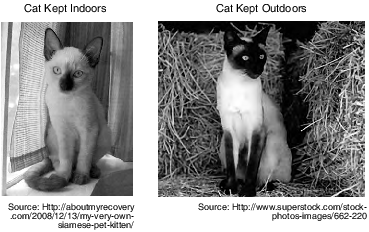
The Siamese breed has a gene that controls fur color. The cat in the first photograph was kept indoors while the cat in the second photograph was kept outdoors. Which statement best explains the differences in fur color between these two cats?
(1) The cat kept indoors is older than the cat kept outdoors.
(2) The environment influenced the expression of fur color genes.
(3) The environment influenced the production of all the proteins in the cat kept outdoors.
(4) The cat kept outdoors has a gene mutation that prevents it from producing light-colored fur.
A photograph of a Siamese cat is shown below.
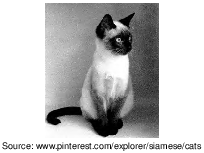
Siamese cats have dark fur on areas of the body that are cooler and light fur on parts of the body that are warmer. The color differences in this Siamese cat are most likely due to
(1) a decrease in glucose produced in areas with light fur
(2) more DNA molecules being produced in areas with light fur
(3) gene expression being influenced by the environment
(4) mutations in the genes for eye color
Identical twins were separated at birth and raised by two different families. Years later, one twin was a physically fit member of the cross-country team, and the other twin was overweight with slightly higher-than-normal blood pressure. The differences in these twins could be explained by the fact that
(1) the genes in the two individuals are completely different
(2) in twins, each individual inherits genes from only one parent
(3) the DNA bases in twins combine differently
(4) the environment can influence the expression of genes
The diagram below represents genetic material.
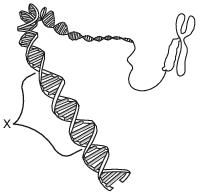
The expression of the section labeled X may be modified by
(1) temperature, only
(2) asexual reproduction
(3) the environment
(4) pH, only
Chlorophyll gives plants their green color. Chlorophyll is produced only when plants are exposed to light, so plants kept in darkness have no chlorophyll and appear white. The best explanation for this is that
(1) chlorophyll is not needed by green plants at night
(2) darkness mutates the chlorophyll genes, causing them to produce a white color
(3) light is required for chlorophyll genes to be expressed
(4) genetic information in cells is not influenced by the outside environment
Twins Don’t Share Everything
…Chemicals called epigenetic markers can be attached to those [inherited] genes, like flags or balloons hanging off the sides of the DNA ladder. These don’t just change the look of the genes. Like pieces of tape stuck over a light switch, these markers can force a gene to remain turned on or off. The type of marker scientists studied in the twins generally sticks the switch in the off position so that some proteins don’t get made. And that means the proteins’ jobs won’t get done.
Every time a cell divides, new epigenetic markers may form. Foods, pollutants, and stress may all contribute to the development of new markers. So throughout our lives we tend to accumulate more and more. But a few are there from the day we’re born.
…His [Jeffrey Craig’s] team found that newborn twins have markers attached to different genes from the very start. It’s true in identical twins, which come from the same fertilized egg. It’s also true in fraternal twins, which come from different fertilized eggs. However, fraternal twins had more such differences than identical twins did.
Source: Science News for Students; July 31, 2012
Identify two environmental factors that can lead to an increase in the number of epigenetic markers that modify gene expression. [1]
Allow 1 credit for two environmental factors. Acceptable responses include, but are not limited to:
• — stress
• — pollutants
• — food
• — smoke/pesticides/alcohol/drugs
• — temperature
New varieties of organisms have resulted from human activities. These organisms have often led to problems in modern society. Two of these new varieties are listed below.
Antibiotic-resistant bacteria Pesticide-resistant insects
Select one of these varieties and discuss a problem associated with the development of this new variety of organism. In your answer, be sure to:
• identify the variety you selected
• identify one biological process by which a population of this variety may develop resistance [1]
• describe how this process is involved in the production of a population of resistant organisms [1]
• identify one problem caused by this resistance [1]
• state one solution to this problem [1]
• identify one possible negative effect of this solution [1]
Variety: ________________________________
The student’s response to the bulleted items in the question need not appear in the following order.
• 13 Allow 1 credit for identifying one biological process by which a population of this variety may develop resistance. Acceptable responses include, but are not limited to:
• — natural selection
• — evolution
• — reproduction
• — mutation
• 14 Allow 1 credit for describing how this process is involved in the production of a population of resistant organisms. Acceptable responses include, but are not limited to:
• Natural Selection:
• — The population had some members that were naturally resistant to antibiotics. They survived and reproduced, passing on the resistance.
• Evolution:
• — Some organisms were resistant to the pesticide. They survived and passed on the trait.
• Reproduction:
• — Resistant members survived and passed on the trait.
• Mutation:
• — It produces variations that give some organisms a survival advantage.
• Note: Allow credit for a response consistent with the process identified in question 13 .
• 16 Allow 1 credit for identifying one problem caused by this resistance. Acceptable responses include, but are not limited to:
• — Resistant bacteria will survive and continue to make people sick.
• — Insects will continue to destroy crops.
• — Antibiotics do not work anymore.
• — There will be less food available.
• 17 Allow 1 credit for stating one solution to this problem. Acceptable responses include, but are not
• limited to:
• — Do not use antibiotics/antibacterial products unless needed.
• — Use different antibiotics or pesticides.
• — Use a natural predator for pests.
• — Insert genes into plants that will make them resistant to bacteria or pests.
• — Research and find new antibiotics/ways of controlling insect pests.
• Note: Allow credit for a response consistent with the problem identified in question 16 .
• 19 Allow 1 credit for identifying one possible negative effect of this solution. Acceptable responses include, but are not limited to:
• — People might be sick longer.
• — More people could get sick.
• — Organisms may become resistant to other treatments.
• — Natural predators may get out of control.
• — Inserted genes may have an undesired effect.
• — Research takes a lot of time and money.
• Note: Allow credit for a response consistent with the student’s solution to question 17 .
For many years, health officials had encouraged using antibacterial hand soap. Today, many scientists recommend using hand soap with no added antibacterial substances. State one reason why using antibacterial hand soap may no longer be recommended. [1]
Allow 1 credit. Acceptable responses include, but are not limited to:
• — Overuse of antibacterial agents may result in an increase in the number of resistant bacteria.
• — Some bacteria are beneficial and may also be killed.
• — Antibacterial agents kill nonresistant bacteria, allowing the resistant ones to survive and
• reproduce.
EVOLUTION OF THE ELEPHANT
Today’s elephants are the result of a long process of evolution. Over millions of years, small changes were passed from one generation to the next. The first fossil elephant species were small, but over time, they increased both in size and weight. The three species alive today are the sole survivors of a once much more widespread group.
Source: www.factmonster.com/dk/science/encyclopedia/evolution.html
Explain why some elephant species did not survive. [1]
Allow 1 credit. Acceptable responses include, but are not limited to:
• — They lacked adaptations to the changing environmental conditions.
• — They were unable to compete for food or other resources.
• — They did not have the variations required for survival in their environment.
